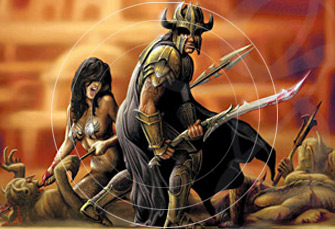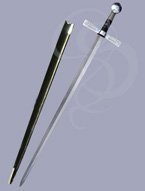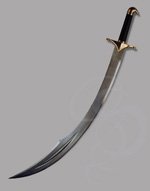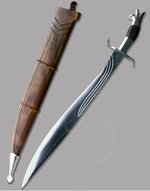
Categories

Fantasy Swords
Face it, we've all got about as much reality as we can handle these days. Escape to a land where good guys win, love is steamy and you never have to mow the lawn.
SBCB-MOULNER
Moulner Falcatus Premium Double Curved Short Sword with Carved Wooden Sheath
$283
In Stock!

SBA-GOTHDREAM
Goth Dream Arming Sword with scabbard
$88
Out of Stock
The GothDream has a historic base but with a bit of a fantasy flare, Based on the arming sword or war spike design, it long, light and very well balanced. The hilt is distinctive yet comfortable to wield.

SBC-FIREDANCERSCIMITAR
The Firedancer - Fully balanced, hand-forged, tempered scimitar
$213
Out of Stock
This is a perfectly balanced, perfectly tempered, hand-forged scimitar. It was created in the world-famous Hanwei forge with temper, balance and craftsmanship as the highest priorities.

SBCB-LAEONIS
Laeonis - Premium Broad-bladed Short Sword with Carved Wooden Sheath
$279
Out of Stock
Fully tempered, battle-ready and razor sharp. Both the blade and grip of the Laeonis have a forward tilt to them that gives maximum leverage when cutting. The blade itself is wide, but still light and comfortable to hold.
Strongblade Lore
(A Bit of History According to Strongblade)
This is a reproduction of type of sword known as the Kilij, or Kilic (depending on your mood and ability to pronounce words ending in 'J'). The Kilij was a fearsome weapon in the Ottoman empire, when men in armless chairs conquered most of the areas of the Mediteranean east of Italy. Okay, so we're kidding about the chairs, but we're serious about the conquering stuff. The Ottoman empire was one of the longest running empires in history, spanning from the late 13th century to the early 20th century.
These backswords were used in the later days of the empire and featured a fearsome flare towards the tip. This flare, known as a 'yelman' did indeed make men yell in fear. Aside from its holy-crap shock value, the yelman gave the sword a better heft towards the front and much more power when used to slash. If you were hit by one of these swords, you were probably going to lose a piece of you.
Some Kilijeses (okay, I truly have no idea what the plural of Kilij is. Deal with it) had even larger flares at the tip, which made the slash even more devestating, but also made the weapon a little more cumbersome. You've seen Kilijesessesees before in movies like Indiana Jones: Raiders of the Last Ark, Aladin and Sinbad. The weapon falls into the Western classification of Scimitar, in the same family as the Shamshir and the Tulwar.
Curved Swords
The exact origin of curved swords is something that has been debated for years. It is generally accepted that the majority of curved swords came from the East.
Curved swords most likely manifested somewhere around Egypt, with the appearance of the khopesh (a weapon somewhere between sickle and sword).
Since then, a number of curved swords began appearing in the East and westerners took to calling such curved swords "Scimitars." Technically, there isn't one sword that is called a scimitar; the term refers to the entire group of curved swords that came from East (excluding the Japanese curved swords). The term may be a derivative of "Shamshir," which was a thin curved sword from Persia, although the shamshir wasn't really popularized until the 1500s. Other scimitars include the Turkish kilij (think of the massive cleaver swords from Aladin and you have a fairly accurate picture), and the Indian Tulwar (somewhere between a shamshir and a kilij). Some smaller curved weapons from the east include the Kopis (a knifelike curved blade that probably was the predecessor of the Khopesh), the Nepalese kukri and the hook-handled falcata of ancient Spain.
Curved swords weren't confined to the east, of course. As the scimitars developed in the east, the west was catching on to the trend. Sabers and cutlasses were slowly conceptualized and developed in Europe. The curved blades were ideal for charging horsemen who tended to lose their straight blades in the bodies of their haplessly impaled foes. The curved sabers could slash opponents and slide off as the horsemen rode by. Another advantage was that curved blades were more compact than straight ones, so horsemen were also able to slash from side to side without worrying about trimming the ears off their horses.
Sailors also liked this compact size, since ship-board combat was often in very close quarters, with a vexing amount of wooden obstacles for swords to get embedded in. This explains the stereotypical image of the pirate holding a cutlass, reinforced recently by Johnny Depp, Orlando Bloom and Kierra Knightley in the Pirates of the Caribbean movies.
Back-Swords
A back sword is a sword that has only one edge. The non-sharp edge of the sword is known as the "back" of the blade. These swords often are curved. Examples of back-swords include most cutlasses, sabers and what westerners refer to as "Scimitars."
Inspired by Model SBC-FIREDANCERSCIMITAR